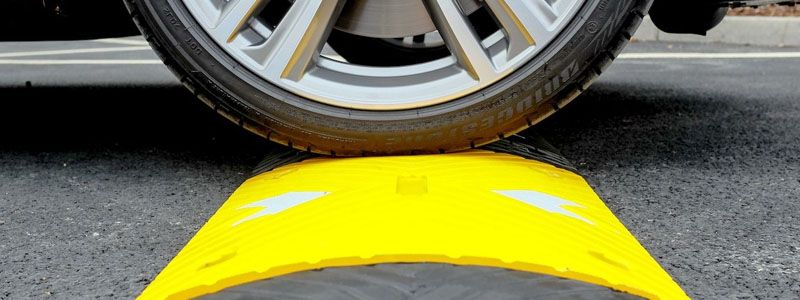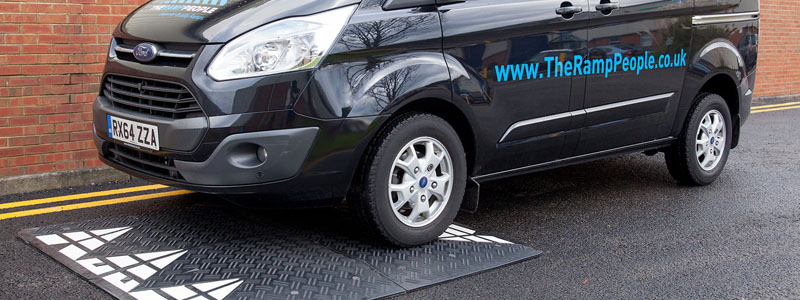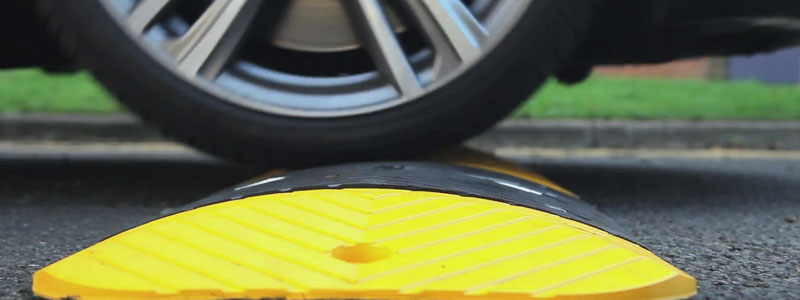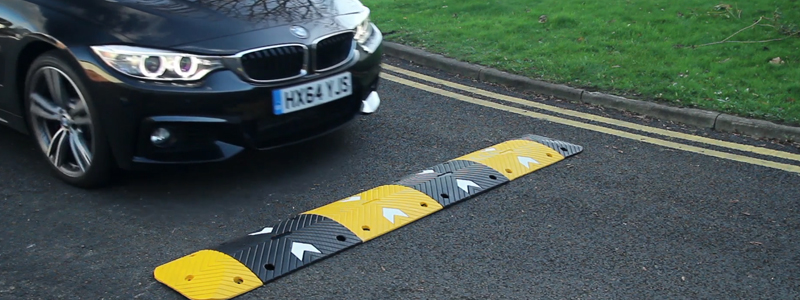
The Highways Road Humps Regulations: Speed Bump Safety
Safety is our number one priority here at The Ramp People; that is why we are dedicated to providing you with top of the range speed bumps for public or private use. We provide premium road ramps and road safety accessories designed to slow motor-vehicle traffic and improve safety. Constructed from heavy-duty impact resistant rubber, our selection of kerb ramps, speed ramps and heavy duty speed bumps provide long lasting security and protection. Speed bumps can be used on both public and private roads to reduce traffic and accidents in problem areas. If your private road is being used as a shortcut or thoroughfare and is excessively busy, or you have noticed a lot of accidents and/or dangerous driving on your road then you might want to think about speed bumps. Councils and highway bodies will also take the initiative to install speed bumps typically in high-risk areas such as schools or roads with high pedestrian footfall. The Highways Regulations (Road Humps) 1999 specify very clear safety measures for the UK’s road humps, ensuring our roads, drivers and pedestrians stay safe and we at The Ramp People must make sure we are aware of the current standards for speed ramp safety, to work with councils and private customers and provide the best service.

What are the different types of road humps and bumps?
There are many measures in place to reduce speed and protect drivers and pedestrians from traffic on our roads; these include Lollypop ladies, chicanes, zebra crossings and road humps made of tarmac.
- Speed Bumps: Perfect for slowing to 5mph & 10mph. Suitable for cars and HGV's. Create any length you wish.
- Speed Cushions: Allows emergency vehicles to easily pass over. Slows cars to 5mph.
- Portable Speed Bumps: Ideal for temporary use.
- Flow Plates: Allows one way traffic control, for example in car parks and industrial estates.

Who to inform?
Local authorities and councils will have their own policies and regulations regarding speed and road safety such as limited miles per hour or which road signs should be in use. However, The Highways Regulations states that in all cases when proposing a public speed bump for the councils’ roads, the chief officer of police, fire brigade and ambulance services must all be made aware and consulted before any action is taken. It’s also a legal requirement to inform any organisations or groups representing people that may be affected by the speed hump system such as bus operators, transport services and residents or traders in the street. If you’re on a private road and are planning on installing speed humps you should inform and consult with other residents on your street to make sure they approve of the plans.
How high can a speed bump be?
The maximum height of a speed ramp must be no more than 100mm, the minimum height is 25mm. The Regulations also state that speed ramps cannot be within the limits of a zebra, pelican or puffin controlled area and the safety dimensions must be as follows;
- No vertical face of more than 6mm.
- No narrower than 900mm.

Other dimensions to consider
To ensure safety and limit the possibility of vehicle grounding, speed bumps should also not be at a steeper gradient than 1:10. You may need to look at shallower gradients depending on other considerations such as the presence of buses, whether emergency services use the route regularly, the incline of the road and so on. Severe speed bumps that reduce car speeds to 10mph or less may only be used on private roads and are not permitted on public highways. https://www.youtube.com/watch?v=6Ozrwtldtx8
Location
Speed humps can only be constructed on roads with a speed limited to 30mph or less. The Highways (Road Humps) Regulations 1999 also outlines other location conditions for speed humps.
- They should not be placed within 30 metres of a zebra-controlled area, including pelican or puffin crossings.
- They cannot be constructed on a railway crossing or within 20 metres of a rail track.
- Speed humps cannot be located under or within 25 metres of a 6.5 metres structure above the surface of the carriage way.
- Above or within 25 metres of any part of a bridge over which the highway passes or any part of a tunnel, culvert or other similar structure which crosses beneath the highway although this regulation does not apply if the road hump is in a zone 20mph or under.
The speed bump regulations state that a road hump may be constructed so that an imaginary line running through the centre length of the road hump from one side of the road to the other may be in line with an imaginary line running through the centre of the zebra crossing patterns or the centre of the crossing limits. For roads that are in a zone with a speed higher than 20mph, the speed bump must also be positioned at a right angle to an imaginary line running along the centre of the carriageway. The speed bump regulations further prohibit speed bumps from being placed.  There are additionally some best practices recommended by councils about the location of speed bumps, namely that an advanced speed-reducing feature should ideally be used to ensure as much as possible that the right speed is not exceeded when the speed bump is reached. For example, placing a speed bump near a junction, a sharp bend or narrowing the road and using give way marks to force a priority-working system can all help to ensure cars slow down to the right speed by the time they reach a speed bump. If a side road leads into a road with road humps, then it is further recommended that the road hump should be met within between 40 and 70 metres depending on traffic flow. For a system of road humps, it’s best practice to leave between 20 and 150 metres between them with 70 metres typically being the best distance depending on the average speed needed to be achieved for the road.
There are additionally some best practices recommended by councils about the location of speed bumps, namely that an advanced speed-reducing feature should ideally be used to ensure as much as possible that the right speed is not exceeded when the speed bump is reached. For example, placing a speed bump near a junction, a sharp bend or narrowing the road and using give way marks to force a priority-working system can all help to ensure cars slow down to the right speed by the time they reach a speed bump. If a side road leads into a road with road humps, then it is further recommended that the road hump should be met within between 40 and 70 metres depending on traffic flow. For a system of road humps, it’s best practice to leave between 20 and 150 metres between them with 70 metres typically being the best distance depending on the average speed needed to be achieved for the road.
Lighting of road humps
Any change in the road such as a crossing or a speed bump must be clearly visible to the driver, especially on the public highways or if you are putting on a large event. The Highways Regulation states that when a speed bump is in place on the highway, it can be lit up by the street lighting surrounding the highway it is placed – only if there are at least three lamps on the street using electricity and they are placed no more than 38 metres apart from each other. You may also provide lighting specifically for the speed bump which could include reflectors or individual lamps either side of the hump; our heavy duty speed bumps come with 8 cats eye reflectors per mid section for simple but clear visibility. 
Signage for speed bumps
If you are looking to use a speed bumps or a speed cushion, you will need to make sure you have appropriate signage to warn road users so they can slow down adequately. The Highways Regulation states that where a road hump is constructed, the Traffic Signs Regulations state you must consider the right warning signs for the presence of your road hump. For example, if your road hump is placed in a 20mph zone you will not need to provide adjoining signage as the speed limit will already be lowered but all other speeds must be considered potentially hazardous. We provide the right speed bump warning signs for all your needs. They are all fully CE-marked and compliant, we use engineer grade prismatic reflective sheeting which offers high colour contrasts for improved visibility, as well as incredible durability. 
Installing speed bumps
Stuck deciding which speed bumps are best for you? View our Speed Bump Product Guide. Our speed bumps our quick and easy to install, for details on speed bump installation click here. 






